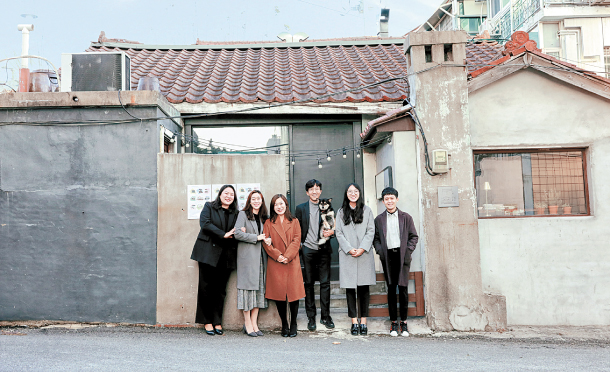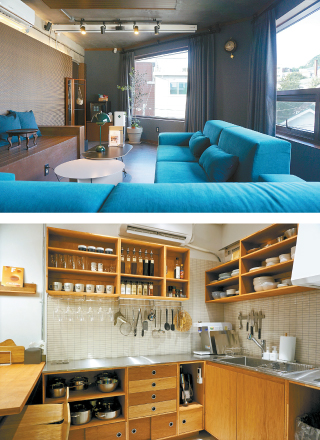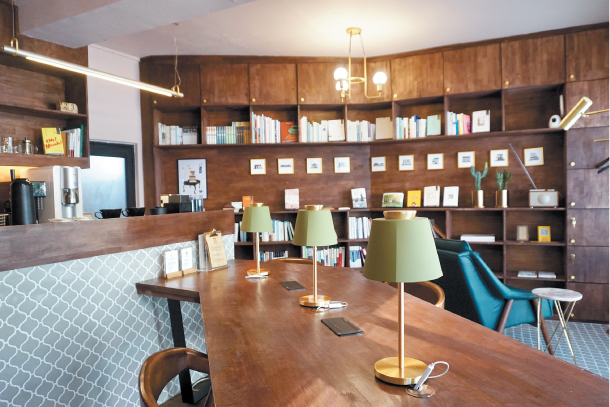The space you need is just around the corner: In Huam-dong, you can rent out a kitchen or library for yourself

The six young architects above started The Huam Project to offer many communal spaces, like a kitchen and a library, to the community. [THE HUAM PROJECT]
If you aren’t able to have that in your own apartment, how about having access to that kind of space outside your home? For those in Huam-dong, in central Seoul’s Yongsan District, it’s now a possibility.
Huam Kitchen, Huam Living Room and Huam Library are only about five minutes away from each other by foot. Anyone, even those from outside of Huam-dong, can rent out the spaces and use them for gatherings or some time alone in a large space.
What’s most attractive is that they are not too expensive to rent. The Huam Kitchen costs between 7,000 won ($5.80) and 10,000 won to rent for half a day. Usually two teams a day occupy the space to cook and enjoy some time together. Young people who live in tight spaces often rent out the property to set up dinner events with friends or family.

Huam Living Room has a sofa and a large screen for comfortable gatherings; people can rent Huam Kitchen to cook and eat with others. [THE HUAM PROJECT]
The Huam Living Room really feels like a cozy living room with a comfortable sofa and a large projector. It costs between 30,000 won and 85,000 won to rent out the space for about four to five hours. Many use this space to hold birthday parties or to have a small movie screening with friends. Some mothers bring their children so that they can talk while their kids entertain themselves.
Huam-dong, located around the base of Mount Namsan in central Seoul, has lots of low-story residential buildings, which are hard to find in Seoul nowadays. Some buildings are made according to a style developed during Japanese colonial rule (1910-45) while others are stand-alone houses or multiple household villas. The neighborhood is somewhat rustic and somewhat romantic at the same time. The six architects who started The Huam Project together saw the charm of the neighborhood early on.
“I wanted to work on something that sympathizes with a region, a village or a city, rather than just constructing a building,” said Lee Jun-hyung, one of the six architects.
Four friends from Sungkyunkwan University’s architecture department gathered together in November 2014 and established an office called Dosi Gonggam, meaning city sympathy. They were searching for a place where a cooperative union could root. They first looked around the Seongbuk-dong area in central Seoul, where many low-story residential buildings can be found, but their search ended up leading them to Huam-dong.
“We, as architects, thought instantly that this is the neighborhood where we wanted to share our stories,” said Lee.
The biggest charm of Huam-dong is that there are many different types of residences, not to mention its location right by Mount Namsan. First, the members decided to record the stories coming from these houses. They visited houses that are over 20 years old, measured everything they could, and interviewed the residents to get more information about their homes and what their lives are like. They laid out blueprints and images in a place they named Huam Garok, a place where records of Huam-dong’s homes are stored. Anyone interested in learning more about the neighborhood can visit for free. Sometimes the space acts as a gallery in the neighborhood and exhibits the works of young and aspiring artists as well as pieces made by children to work as a small gallery in town.
While they researched the houses in the area, they started to think more about the life of young people in their small homes all across Seoul. Naturally they started to think about the concept of sharing.
“We started to think that the neighborhood could offer what’s not available in their individual homes,” said Lee, explaining the early days of The Huam Project, which created a communal kitchen, and then the library.

At Huam Library, people can have small gatherings for book talks and seminars [THE HUAM PROJECT]
For all these communal spaces, the team made the most of the existing buildings and refrained from using striking signage so that the new spaces could fit in with the rest of the neighborhood as if they had existed for a long time. They also made sure to use spaces with low rent.
The kitchen is about 10 square meters (110 square feet) and has all the necessary kitchenware and a table inside. The inside is decorated with wood, and the light is not too bright to make visitors feel comfortable enough to think that the space is really a part of their own home.
Reservations can be made online or though a phone call. The passcode to enter is usually sent via text message. There is a CCTV camera in case of an emergency, and the team’s office is also nearby. At first, the team worried if they could even afford to pay the rent of all these places, but all of the spaces have become very popular, especially Huam Kitchen, as more people try to cook more and then share their food with others.
“We take pride in the fact that what we do is provide a variety of options to people looking for space to do certain things,” said Lee.
In the guest book left at the Huam Library and others, many have left stories of how they enjoyed the space.
“We made a kind of shell that can be shared, and filled inside that shell is the people who used the space,” said Lee. “Huam-dong is not very popular and doesn’t need to worry about gentrification yet, but if that happens and if the outside investment that temporarily came in all disappears, what we need to do is keep the neighborhood [steady].”
“We want to make a space that isn’t too susceptible to trends so that we can make the space and keep it for a long time.”
BY YOO JI-YEON [summerlee@joongang.co.kr]
원룸 등 협소한 집에 사는 이들에겐 널찍한 주방, 나만의 독립된 서재같은 공간을 갖는 게 로망이다. 그렇다면, 집 바깥 공간에서라도 할 수 있다면 좋지 않을까. 서울 용산구 후암동에 가면 해답이 있다. 물론 나의 소유는 아니지만 말이다. ‘후암주방’ ‘후암거실’ ‘후암서재’. 집 밖으로 나온 공유 공간이 5분 거리에 옹기종기 모여있다. 필요할 때 비용을 내고 쓸 수 있는 나만의 주방, 거실, 서재다.
후암주방은 반나절에 7000~1만원을 내고 쓴다. 보통 하루 두 팀(한 달 평균 50~55팀)이 음식을 해 먹으며 추억을 쌓는다. 주로 협소한 공간에 사는 청년들이 친지·친구와의 식사 모임을 위해 공간을 빌린다.
후암서재엔 책꽂이와 책, 테이블과 소파, 싱크대 등이 구비돼 있다. 4인이 8시간 이용 시 비용은 5만원. 책 읽기에도, 회의나 소규모 모임을 하기도 좋다. 후암동 주민들의 이용률이 높은 곳이다. 단골도 많다. 청년층부터 40대까지 고객 연령대가 다양하다.
후암거실은 말 그대로 여느 가정집 거실처럼 너른 소파가 있고, TV를 대신한 빔프로젝터가 비치돼 있다. 4~5시간에 3만~8만5000원. 생일파티부터 영화 감상, 독서 모임 등을 열기 좋은 곳이다. 어린아이를 둔 주부들의 모임 장소로 애용된다.
남산 자락의 구릉 지대에 있는 후암동은 서울에선 찾기 쉽지 않은 저층 주택지다. 단독 주택과 빌라, 일제 강점기 적산 가옥이 섞여 있는, 낡은 듯 로맨틱한 곳이다. 후암동의 매력을 일찌감치 알아보고 이 공유 공간들을 만든 건 젊은 건축가 6명으로 이뤄진 ‘도시공감협동조합’. 조합의 이준형(36) 건축가를 지난 주 만났다.
이준형 건축가는 “건축물을 만드는 것보다 지역이나 마을, 도시에서 사람들과 공감하는 일을 하고 싶다는 바람이 있었다”고 말한다. 성균관대 건축학과 선후배 6명이 의기투합해 2014년 11월 건축 사무소를 만들고 이름을 ‘도시공감’으로 지은 이유다. 협동조합이 뿌리내릴 수 있는 곳을 찾으려 성북동 등 서울의 오래된 저층 주거지를 돌아다녔다. 그러다 2016년 여름 우연히 후암동까지 왔다. 이씨는 “건축가로서 우리만의 이야기를 펼쳐 나가고 싶은 동네라는 생각이 직관적으로 들었다”고 했다.
후암동의 가장 큰 매력은 주택의 다양한 형태가 남아있다는 점이다. 해방 이후부터 최근까지 70여년 역사 속 가옥 형태가 혼재돼 있다. 남산 아래 구릉지라는 지형도 매력적이었다. 높은 집에서 보이는 낮은 집들의 모습, 낮은 집에서 보이는 높은 집들은 독특한 풍경이다.
맨 먼저 20년 이상 된 주택을 돌며 실측하고 거주자 인터뷰로 집과 삶에 관한 이야기를 기록했다. 이를 도면과 이미지로 정리해 ‘후암가록(家錄)’이란 공간을 만들어 전시했다. 말 그대로 후암동의 집을 기록한다는 의미. 후암동이 궁금한 누구나 무료로 들를 수 있다. 젊은 작가나 동네 아이들의 그림을 전시하기도 한다. 후암동의 작은 갤러리인 셈이다.
청년 건축가들이 집에 대해 고민하면서 ‘공유’개념을 떠올린 것은 자연스럽다. 집값 비싼 서울에서 젊은 세대는 작은 집을 선택할 수밖에 없다. 이씨는 “집에서 많은 것을 할 수 없는 사람들에게 마을이 그 일을 하면 어떨까 떠올렸다”고 한다. 집 밖으로 나온 공유 공간, 후암 프로젝트의 시작이다.
먼저 빈 상가를 개조해 2017년 3월 후암주방을 만들고, 몇 개월 후 서재를 만들었다. 지난해 7월엔 후암거실도 만들었다. 공사 중인 후암별채는 다음 달 문을 연다. 한나절 도심 속에서 책 읽고 차도 마시고 목욕을 하며 시간을 보낼 수 있게 기획된 1인 휴식 공간이다. ‘호캉스(호텔+바캉스)’의 공유 버전인 셈.
기존 건물을 살리고, 간판도 튀지 않게 해 후암동에 공간이 자연스레 녹아들도록 했다. 상대적으로 낮은 임대료의 빈 자투리 상가를 활용했다. 후암주방만 해도 약 10㎡(3.2평) 남짓 공간에 조리 및 주방 소도구, 번듯한 식탁을 다 갖췄다. 실내는 목재를 주로 쓰고 조명도 너무 밝지 않게 했다. 내가 빌린 시간만큼은 내 집에서 머무는 것 같은 아늑함을 살리기 위해서다.
예약은 온라인이나 전화로, 비밀번호 등 안내는 문자로 진행한다. 입구에 CCTV도 있고, 건축 사무소가 근방에 있어 비상상황엔 대비할 수 있다. “월세나 낼 수 있을까” 고민했지만, 예약이 줄 설 정도로 인기가 많다고 한다. 특히 후암주방은 먹방·쿡방 등 요리와 먹을거리에 관심이 커진 사회적 분위기, 특별한 날 직접 한 요리를 가까운 이들과 나누고 싶어하는 젊은이들의 욕구와 맞아 인기가 높다.
공간을 소유하기 어려운 이들에게 복지의 형태로 공간을 빌려준다는 의미에서 ‘공간 복지’의 개념도 있다. 이준형 건축가는 “후암 프로젝트는 무상이 아니어서 공간 복지라는 거창한 말을 붙이는 게 맞는지 모르겠다”면서도 “사람들에게 다양한 공간 선택지를 준다는 데 의미를 둔다”고 말한다.
후암서재 등에 비치된 방명록엔 이곳을 이용한 이들의 이야기가 빼곡하다. 이씨는 “공유 공간이라는 껍데기를 만들었더니 이용객들이 알맹이를 채워줬다”고 말한다. 이어 “아직 후암동은 젠트리피케이션(둥지 내몰림)을 논할 정도로 뜨거운 상권은 아니지만, 후에 우후죽순 밀려들어 온 자본이 빠져나갔을 때 남은 자리에서 해결책을 찾는 것도 우리의 역할”이라며 “유행 타지 않는 공간을 만들고 오랫동안 유지하고 싶다”고 덧붙였다.
유지연 기자










with the Korea JoongAng Daily
To write comments, please log in to one of the accounts.
Standards Board Policy (0/250자)